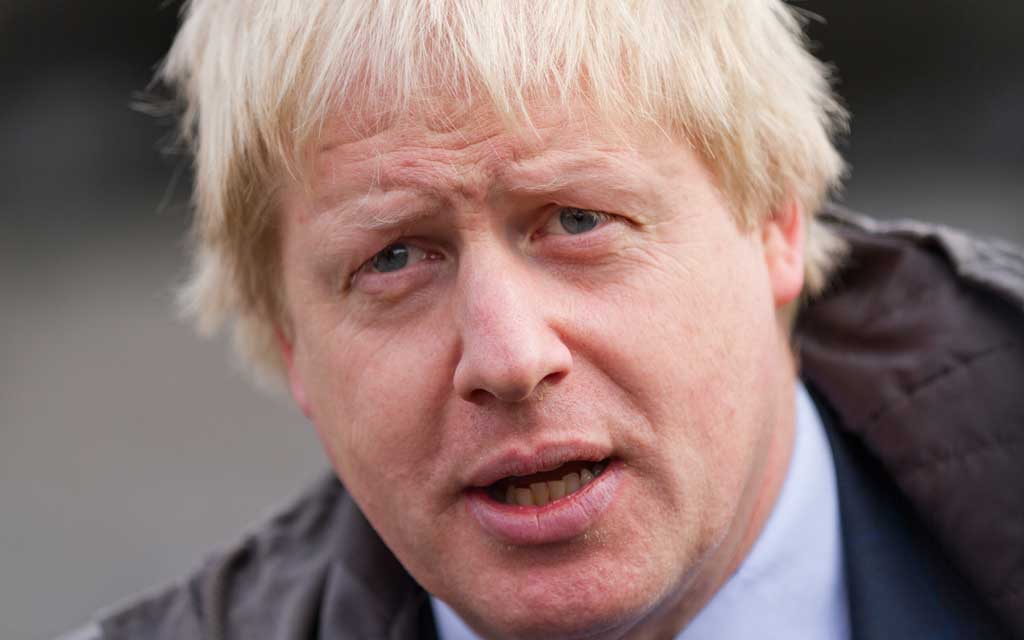
Media coverage of the EU Referendum (report 1)
This is the first in a series of reports by the Loughborough University Centre for Research in Communication and Culture on national news reporting of the 2016 EU Referendum.
The results in this report are derived from detailed content analysis of news coverage of the EU Referendum produced on the weekdays (i.e. Monday to Friday inclusive) between 6 May and 18 May from the following news outlets:
Television: Channel 4 News (7pm), Channel 5 News Tonight (6.30pm), BBC1 News at 10, ITV1 News at 10, Sky News 8-8.30pm.
Press: The Guardian, Times, Daily Telegraph, Financial Times, Daily Mail, Daily Express, Mirror, Sun, Star and the I.
We analysed all EU Referendum related news found in the entire duration of all the above named television programmes. For the press, we included referendum news found on the front page, the first two pages of the domestic news section, the first two pages of any specialist election section and the page containing and facing the papers’ leader editorials. Two inter-coder reliability tests were conducted to check the robustness and consistency of these measures.
Regarding our terminology and coding protocols: we use the term ‘IN’ to indicate individuals and organisations supporting the case for the UK to remain in the European Union. We use the term ‘OUT’ for those advocating the UK’s departure from the EU. We do not categorise people or organisations according to our prior knowledge of their political viewpoints. Rather, individuals or organisations are only assigned to these categories when their affiliations are manifestly stated in editorial content and/or they articulate support for one of these positions.
The report has three sections, assessing:
- Issue Balance – what topics received most coverage?
- Stopwatch Balance – which individuals or institutions featured most frequently?
- Directional Balance – did news coverage tend to favour proponents or opponents of continued UK membership of the European Union?
Download the report
UK News Coverage of the 2016 EU REFERENDUM report 1 (PDF)
Executive summary
This initial analysis demonstrates the narrowness of news coverage of the referendum so far. Reporting mostly focused on the process and conduct of the campaign, and in particular the personal rivalries it has exposed at the heart of the government. In terms of substantive content, coverage of issues to do with business, trade and the economy were most reported, receiving twice as much prominence as ‘Immigration/ border controls’. A wide range of other issues related to the vote (the implications for the environment, travel, social rights, constitutional issues) barely registered.
The narrowness of the issue agenda was reflected in the limited the range of reported participants. Conservative party sources dominated press and TV reporting, in particular the actions and interventions of David Cameron, Boris Johnson and George Osborne. The new era of multi-party politics in the UK is not reflected in Referendum coverage since polling day a couple of weeks ago: Labour voices have been side-lined and the Lib Dems, SNP and other parties are virtually invisible.
Beyond the party political sphere, only a small number of civil society voices (i.e. trade unions, NGOs, citizens) gained any media presence In contrast, government agencies and business and corporate sources secured small but not insignificant profiles. At this stage, it is difficult to discern whether ‘remain’ or ‘leave’ is winning the media war.
Section 1: Issue balance
This section examines the issue agenda in the reporting of the referendum during the sample period. What issues have dominated coverage so far, and what have failed to attract much attention? (see Table 1.1)
Table 1.1 Most prominent Issues (6 May – 18 May 2016)
| TV | Press | ||
|---|---|---|---|
| 1 | Referendum conduct | 31.8% | 33.8% |
| 2 | Business/economy/trade | 20.6% | 20.7% |
| 3 | Immigration/border controls | 11.2% | 10.9% |
| 4 | Defence/military/security | 7.1% | 8.4% |
| 5 | Constitutional/legal/judicial issues | 5.9% | 6% |
| 6 | Opinion polls/citizen engagement | 6.5% | 3.8% |
| 7 | Employment | 4.0% | 4% |
| 8 | European Union bodies/history/activities |
2.9% |
1.3% |
| 9 | Standards/sleaze/corruption | 1.2% | 2% |
| 10 | Housing/property issues | 1.2% | 1.5% |
| 11 | Environment | 0% | 1.7% |
| 12 | Health and health care provision | 0.6% | 0.8% |
Note: up to three issues could be coded per news item. To be coded, an issue reference needed to occupy at least THREE FULL SENTENCES in an article, or 10 SECONDS of broadcast time. Where more than three issues were addressed, the most prominent were coded.
Key Findings
- The process and conduct of the referendum campaigns attracted most media attention.
- The most prominent substantive issue was business and economics and whether UK plc will be helped or hindered by staying in or leaving. This issue was equally prominent on TV and in the press.
- In contrast immigration/ border control was only about half as prominent as business and economic in news coverage
- This was a very narrow debate. The top four issues accounted for 71% of all issues in terms of TV coverage, and 74% of press coverage.
- Other issues were marginalised e.g. the implications of the referendum vote for Scottish independence are almost entirely ignored.
Commentary: A narrow debate on a few issues
The dominance of coverage of the process and conduct of the EU referendum is not unusual for political reporting of this kind (similar trends are found in the reporting of General Elections). The conduct of the referendum campaign is of added importance because it has implications for the future of the Conservative government (will Cameron remain Prime Minister? Will the government make effective use of its slim majority given divisions in the Party?) and the next Conservative leadership election (will it be Osborne, Johnson or another who triumphs?).
The clear prominence of coverage of business and the economy over immigration issues is good news for the IN campaign: the economic arguments for staying are central to their attempts to persuade undecided or wavering voters. Conversely it t is not so good news for the OUT campaign given immigration is a key issue that resonates with their potential supporters.
Various issues are highly marginal, attracting little or no coverage, which indicates the narrowness of the EU debate in media reporting at this stage in the debate. Significantly the implication of the Referendum vote for UK devolution was not covered by TV news and there was only one press article in our sample period. Issues such as the environment and employment rights attracted little attention in a debate dominated by Conservative and business actors. Farming received scant attention despite being a sector whose fortunes are intimately tied to EU policy- making.
Section 2: Stopwatch balance:
This section examines which individuals, organisations and institutions received most media coverage for the sample period. Table 2.1 shows the top 10 most frequently reported individuals.
Table 2.1: ‘Top Ten’ by frequency of appearance
| Rank | Actor | TV | Press |
|---|---|---|---|
| 1 | Boris Johnson (Con) | 9.2% | 10.5% |
| 2 | David Cameron (Con) | 7.9% | 10% |
| 3 | George Osborne (Con) | 2.1% | 5.1% |
| 4 | Iain Duncan Smith (Con) | 3.3% | 4.3% |
| 5 | Nigel Farage (UKIP) | 2.1% | 2.7% |
| 6 | Michael Gove (Con) | 2.1% | 2.0% |
| 7 | Jacob Rees-Mogg (Con) | 0.8% | 1.6% |
| 8 | Jeremy Corbyn (Lab) | 1.7% | 1.2% |
| 9 | Gordon Brown (Lab) | 1.7% | 1.1% |
| 10 | Norman Lamont (Con) | 1.7% | 1.0% |
Key findings
- Boris Johnson is the leading voice in the campaign so far, both on television and in the press. David Cameron comes in a close second, with Chancellor George Osborne third . Overall, these three politicians account for 25% of all news sources identified in Referendum coverage sampled in this report.
- The prominence of the aforementioned politicians means the top three individuals in the campaign are all relatively recent in terms of their public declaration to either support IN or OUT. By contrast longstanding advocates of the rival sides such as Nigel Farage are less prominent or, like Labour’s Alan Johnson, fail to make the top ten.
- Non-Conservative parties’ spokespeople were either comparatively marginal (Labour) or don’t feature in the top 10 (SNP, LibDem and Green).
- No women make the top ten.
Table 2.2 compares the relative prominence of women to men across all coverage and confirms that the absence of female representation in table 2.1 is indicative of a wider underrepresentation in Referendum coverage sampled here. The gender gap was greatest in the press, but women were also significantly marginalised in TV reporting.
Table 2.2: Relative prominence of women to men in Referendum coverage
| TV | Press | |
|---|---|---|
| Women | 16% | 9% |
| Men | 84% | 91% |
Table 2.3 aggregates individuals and groups by wider categories (e.g. by political party).
Table 2.3: News presence of groups/organisations/institutions.
| TV | Press | |
|---|---|---|
| % | % | |
| Conservative | 41 | 44 |
| Labour | 6 | 10 |
| UKIP | 2 | 2 |
| Lib Dem | – | 1 |
| SNP | – | 0.1 |
| Other party | 1 | 0.2 |
| Media sources/celebrities | 1 | 1 |
| Experts/think tanks | 8 | 2 |
| Business | 4 | 9 |
| Public sector | – | 3 |
| NGO | 1 | 0.2 |
| Trade union | – | 0.5 |
| Religious | 1 | 0.2 |
| Citizens | 10 | 1.2 |
| Referendum pressure group | 3 | 9 |
| Government/Govt agency | 8 | 8 |
| Pollsters | – | 0.4 |
| EU organisations | – | 1 |
| Other international organisation | 5 | 1 |
| EU member state | 1 | 1 |
| Other non-UK source | 9 | 4 |
(Note: Up to 5 actors could be coded per item. Where more than 5 were featured, the most prominently quoted and positioned were coded. Percentages have been rounded and totals may exceed 100)
Key findings:
- The prominence of Conservative politicians in table 2.1 is reflected in the party’s overall dominance of all Referendum coverage. Labour party sources featured four times less frequently.
- While UKIP managed to gain a limited profile other political parties, notably the SNP, barely featured during this sample period.
- Outside of the party political sphere, ‘government departments/agencies’ gained some relative prominence in both press and TV reporting.
- Business sources attained greater presence in newspaper reporting than on television.
- Citizens gained more prominence in TV reporting than the press.
- Pressure groups set up to campaign on the Referendum (NB aside from LEAVE and REMAIN) had more prominence in press reporting than TV.
- Representatives of supranational organisations gained more coverage on television than in the newspapers
- Non-UK based sources were relatively peripheral in both TV and press coverage.
Commentary: Three Men and a Vote
In both press and TV coverage, the EU referendum is largely a ‘Tory Story’ so far, dominated by three figures who have been implicated in a future Conservative party leadership contest. Other civil society groups and the public were squeezed to the margins of coverage. Citizens were essentially by-standers in the press, although there was more effort by broadcasters to include public perspectives. NGOs and trade unions were almost nowhere to be seen. In contrast, the voice of business secured a small but significant presence.
The prominence of government department/agencies is noteworthy. This presence is largely explained by the recent intervention of Mark Carney, Governor of the Bank of England, who warned about the economic risks of leaving the EU. This gained greater traction in TV than in press coverage. Elsewhere, international/non-UK actors gained some coverage, but for all that the EU Referendum debate remains a decidedly British affair. Finally, despite the abundance of ‘campaign process’ coverage noted earlier, the pollsters hardly made a showing.
Section 3: Directional balance
Directional balance assesses the favourability of coverage towards different campaigns and campaigners. We have developed several measures for this aspect of coverage, the first of which quantifies the balance between different stances of the individuals and organisations engaged in the debate.
Party politics
The Referendum campaign has presented major challenges to the unity of political parties, most notably the Conservatives. Figures 3.1 & 3.2 compare the divisions of opinion within parties about the referendum vote, in press and television coverage respectively.
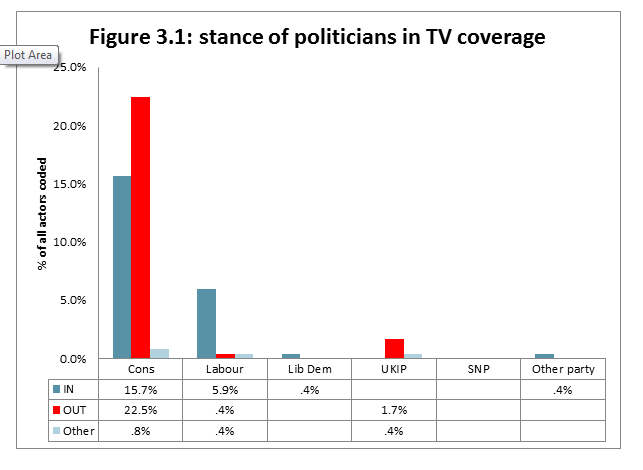
Figure 3.1: stance of politicians in TV coverage
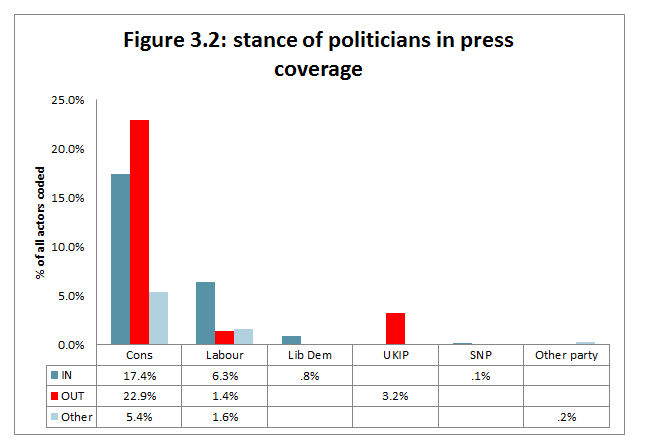
Figure 3.2: stance of politicians in press coverage
Key points
- Divisions within the Conservatives were far more evident in press and broadcast coverage, both in actual and proportional terms, than for any other party.
- Conservative OUT supporters received more coverage than Conservative IN supporters.
- Labour IN supporters exceed Labour OUT campaigners by a ratio of more than 5:1.
- The only other notable party political intervention was from UKIP, whose advocacy for leaving the EU gained slightly more proportional prominence in the press than TV.
Tables 3.3 and 3.4 compare the respective stances of a selection of institutions, individuals and organisations beyond the party political sphere.
Key findings
- Referendum groups supporting OUT (NB outside of the formal REMAIN campaign) gained more prominence in press than TV coverage.
- In both press and TV reporting, groups advocating OUT exceeded the presence of their rivals campaigning for the UK to remain in the EU.
- TV coverage gave some prominence to the views of citizens, with anti-EU opinion marginally exceeding pro-EU viewpoints. The press, in contrast, assigned very little coverage to lay-voices and opinion.
- Government sources (i.e. departments, appointed bodies, government agencies) were mainly featured in TV as supporting the case for remaining in the EU. This patterning was less evident in their press appearances.
- Business sources supporting IN exceeded those supporting OUT in both press and TV coverage.
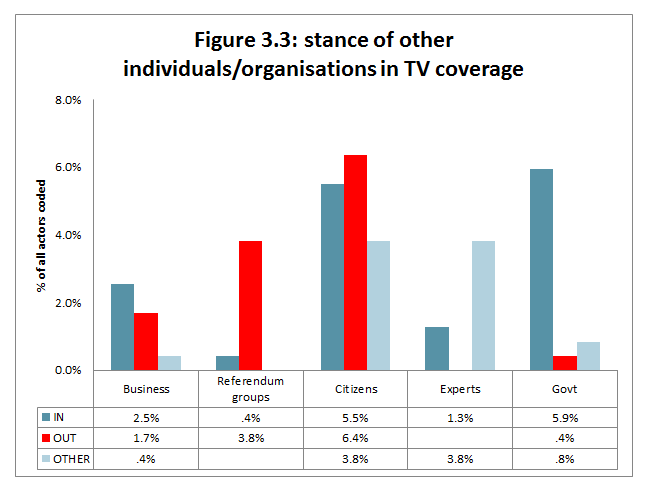
Figure 3.3: stance of other individuals/organisations in TV coverage
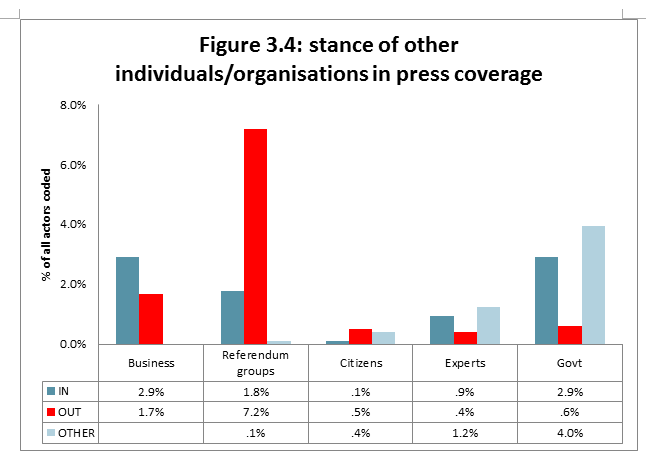
Figure 3.4: stance of other individuals/organisations in press coverage
Overall patterns of IN and OUT stances
Table 3.5 provides an aggregation of the stances of all individuals and organisations featured in the sample period.
Findings:
- Individuals or organisations articulating the IN position were marginally more frequently reported than those supporting OUT.
- The margin of difference was greatest with TV coverage (5% compared with 1%).
- In both press and TV, 1 in 5 of featured sources either did not express a position on the Referendum or voiced mixed views.
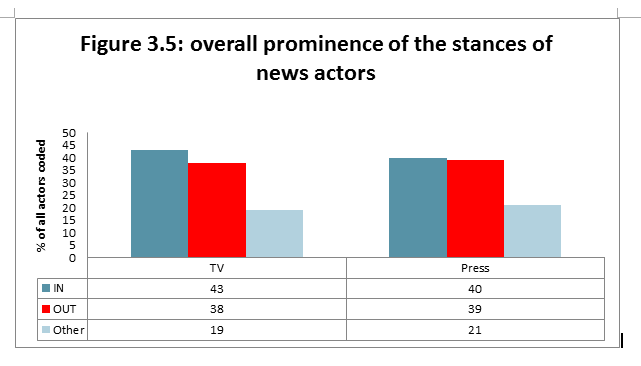
Figure 3.5: overall prominence of the stances of news actors
Defence and offence
To develop our analysis of directional balance, we also measured the frequency with which advocates of IN or OUT were reported ‘on the front foot’ – attacking their opponents or advancing their arguments – or ‘on the back foot’ – responding to the claims of others or defending themselves from attack.
Key findings
- Both sides were more frequently reported ‘attacking’ rather than ‘defending’.
- In TV news, IN campaigners were more frequently featured in an attacking posture than OUT campaigners.
- The margin between IN and OUT campaigners ‘on the front foot’ was markedly less substantial in press coverage.
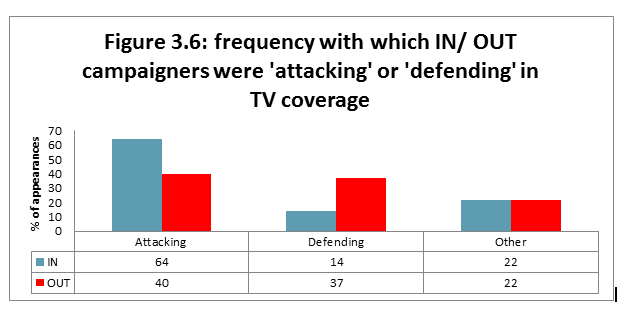
Figure 3.6: frequency with which IN/ OUT campaigners were ‘attacking’ or ‘defending’ in TV coverage
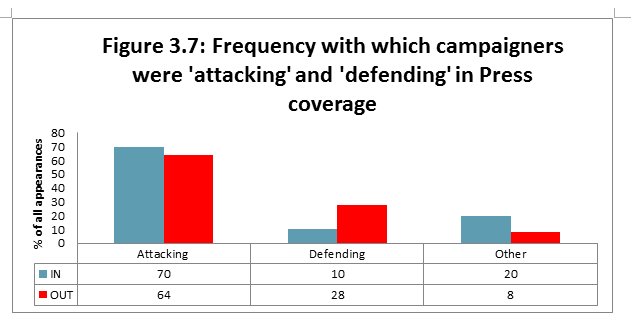
Figure 3.7: Frequency with which campaigners were ‘attacking’ and ‘defending’ in Press coverage
Overall story evaluations
As a final measure, we made an ‘in-the-round’ assessment of the extent to which the evaluative implications of each news item tended to support either IN or OUT positions (in assessing this we considered the dominance of particular news stories and the relative positioning and accessing of political actors within the item.)
The results of this analysis are set out in Table 3.1.
Key findings:
- The majority of TV news report had no clear evaluations that benefitted particular campaign positions.
- Where evaluations were evident in TV news, those supporting arguments to remain in the EU exceeded those supporting the UK’s departure.
- In the press, the majority of items were framed in ways that supported either IN or OUT positions.
- In the press, OUT evaluations were more prominent than IN evaluations.
Table 3.1: Item Evaluations
| TV | Press | |
|---|---|---|
| IN Evaluations | 29% | 26% |
| OUT Evaluations | 10% | 32% |
| No Evaluations/ No Dominant Evaluations | 61% | 42% |
Commentary: It’s still too close to call
The cumulative results on directional balance suggest some distinction between press and TV coverage of the referendum campaign. TV news coverage was more favourable to the IN campaign, according to a range of measures. Individuals or organisations advancing the case for remaining in the EU were more frequently reported than their opponents. They were less defensive in their reported stances. And, although quoted less extensively than OUT campaigners, the ‘quotation gap’ was appreciably lower than found in press coverage. In press coverage, the directional division was closer and more polarised. However, these differences should not be overstated and do not provide strong grounds for arguing that any side is ‘winning’ the media war yet in terms of favourability of treatment during the two week period sampled.